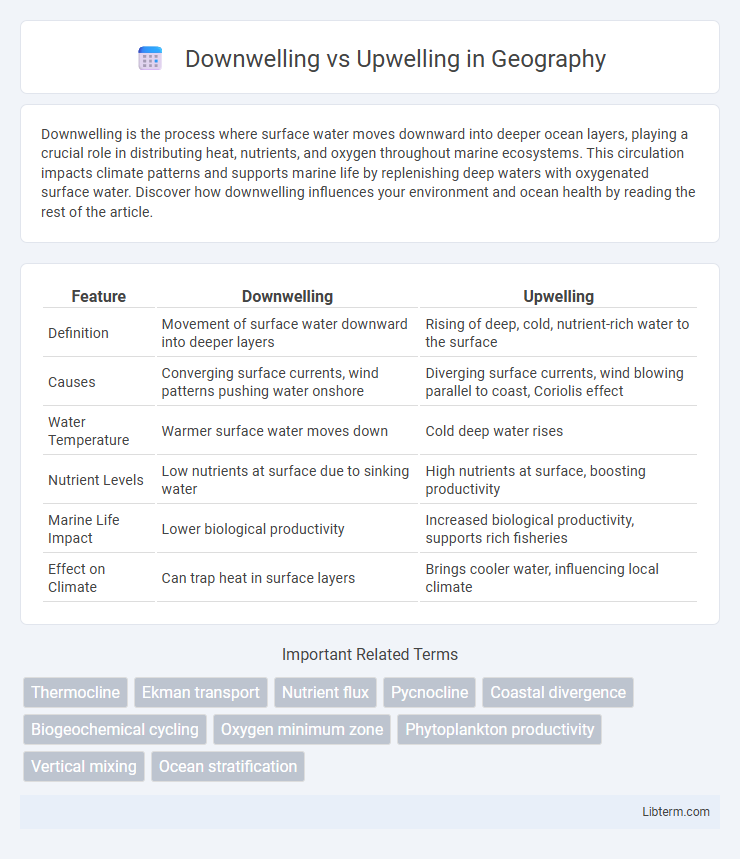Downwelling is the process where surface water moves downward into deeper ocean layers, playing a crucial role in distributing heat, nutrients, and oxygen throughout marine ecosystems. This circulation impacts climate patterns and supports marine life by replenishing deep waters with oxygenated surface water. Discover how downwelling influences your environment and ocean health by reading the rest of the article.
Table of Comparison
| Feature | Downwelling | Upwelling |
|---|---|---|
| Definition | Movement of surface water downward into deeper layers | Rising of deep, cold, nutrient-rich water to the surface |
| Causes | Converging surface currents, wind patterns pushing water onshore | Diverging surface currents, wind blowing parallel to coast, Coriolis effect |
| Water Temperature | Warmer surface water moves down | Cold deep water rises |
| Nutrient Levels | Low nutrients at surface due to sinking water | High nutrients at surface, boosting productivity |
| Marine Life Impact | Lower biological productivity | Increased biological productivity, supports rich fisheries |
| Effect on Climate | Can trap heat in surface layers | Brings cooler water, influencing local climate |
Introduction to Downwelling and Upwelling
Downwelling occurs when surface water moves downward into deeper ocean layers, transporting oxygen and nutrients from the surface to marine ecosystems below. Upwelling, conversely, involves the rising of cold, nutrient-rich waters from the deep ocean to the surface, promoting high biological productivity and supporting fisheries. Both processes are driven by wind patterns and ocean currents, playing critical roles in global climate regulation and marine food chains.
Defining Downwelling: Key Concepts
Downwelling refers to the vertical movement of surface water sinking into deeper ocean layers, driven by factors such as wind patterns and water density differences. This process increases oxygen and nutrient levels in deeper waters, supporting marine ecosystems and influencing global climate. Understanding downwelling is crucial for studying ocean circulation and its impact on carbon cycling and heat distribution.
What is Upwelling? An Overview
Upwelling is a crucial oceanographic process where deep, cold, and nutrient-rich waters rise to the surface, enhancing marine productivity and supporting diverse ecosystems. This phenomenon primarily occurs along coastlines and equatorial regions due to wind patterns and the Coriolis effect driving surface waters away. Upwelling zones are vital for global fisheries, as the influx of nutrients stimulates phytoplankton growth, forming the base of the marine food web.
Physical Processes Behind Downwelling
Downwelling occurs when surface water converges and is forced downward, often driven by wind patterns and changes in water density. This process transports oxygen-rich surface waters to deeper ocean layers, influencing marine life and nutrient distribution. Physical factors such as Ekman transport, water column stability, and temperature gradients play crucial roles in facilitating downwelling events.
Mechanisms Driving Upwelling
Upwelling occurs when winds push surface water away from an area, allowing colder, nutrient-rich water from deeper layers to rise to the surface. This process is primarily driven by Ekman transport, where the Coriolis effect causes surface waters to move at an angle to the wind direction. Coastal winds and ocean currents play a critical role in enhancing upwelling zones, vital for supporting marine ecosystems and boosting fisheries productivity.
Environmental Impacts of Downwelling
Downwelling transports oxygen-rich surface waters to deeper ocean layers, enhancing marine life habitats and supporting diverse ecosystems. This process can mitigate hypoxia in bottom waters by increasing oxygen availability, which is critical for benthic organisms. However, downwelling may also trap nutrients at depth, reducing surface productivity and impacting fisheries dependent on nutrient-rich upwelled waters.
Upwelling and Marine Ecosystem Productivity
Upwelling is the process where deep, nutrient-rich waters rise to the ocean surface, significantly enhancing marine ecosystem productivity by supplying essential nutrients like nitrates and phosphates that stimulate phytoplankton growth. This influx of nutrients supports a diverse food web, from microscopic algae to large fish populations, making upwelling zones some of the most biologically productive areas globally. Regions such as the Humboldt Current and the California Current are well-known for their intense upwelling and consequent high fisheries yields.
Downwelling vs Upwelling: Key Differences
Downwelling involves the sinking of surface water to deeper ocean layers, typically driven by wind patterns and convergence zones, while upwelling brings cold, nutrient-rich deep water to the surface, usually caused by divergence and wind-driven Ekman transport. Key differences include temperature variations, with downwelling transporting warmer surface water downward and upwelling elevating cooler water upward, and ecological impacts, where upwelling supports high biological productivity compared to the nutrient-poor conditions often seen in downwelling areas. These processes critically influence marine ecosystems, climate regulation, and ocean circulation dynamics.
Global Examples of Downwelling and Upwelling Zones
Downwelling zones commonly occur along the eastern coasts of continents such as the U.S. East Coast and the Mediterranean Sea, where surface waters converge and sink, transporting oxygen-rich water to deeper layers. Upwelling is notably prominent along the western coasts of continents, including the coast of California, Peru-Chile, and northwest Africa, where nutrient-rich cold water rises to the surface, promoting high primary productivity and supporting major fisheries. These global upwelling and downwelling zones significantly influence marine ecosystems, regional climate, and biogeochemical cycles.
Importance for Climate and Fisheries Management
Downwelling transports warm, oxygen-rich surface waters downward, influencing ocean circulation and climate regulation by redistributing heat and supporting deep-sea ecosystems critical for carbon sequestration. Upwelling brings nutrient-rich cold waters to the surface, boosting primary productivity and sustaining major fisheries, which are vital for food security and economic stability in coastal regions. Effective management of fisheries depends on understanding upwelling patterns, while climate models incorporate both processes to predict changes in marine biodiversity and atmospheric conditions.
Downwelling Infographic

 libterm.com
libterm.com